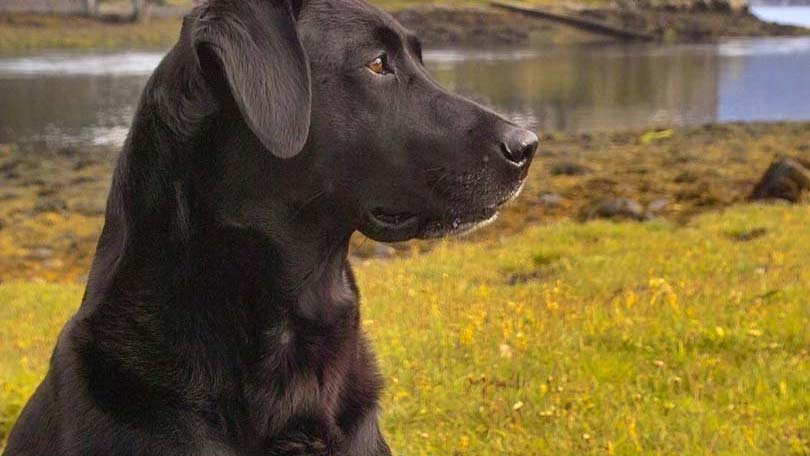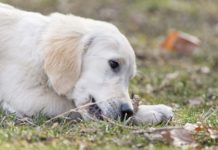
The Labrador Retriever is again the most popular AKC breed in the U.S.A. Additionally, they lead in nearly every major city. With a generally friendly, happy demeanor, an adaptability to many situations and intelligence to be trained for a wide host of duties, it’s little wonder that this breed is so well loved.
The Labrador is so dominant in our culture that nearly any short haired medium sized black dog is deemed a “Lab cross”. By the standard they actually are 22-1/2 to 24-1/2 inches at the shoulder, with females slightly smaller, and weigh 65-80 pounds.
This is a breed that was developed to work. The extreme variety of work they have eagerly taken on and learned is a testimony to the breeding for function. A short, dense, hard coat allows the breed to work in all types of weather. Black, yellow or chocolate is the accepted colors, with a distinct thick tail that isn’t like any other breed. The purebred labrador is a square, stocky dog that has the image of power, a dog that moves freely without being too heavy.
The typical Labrador enjoys being outside with people, and especially is drawn to water. This is instinctive as they have long been used for retreiving waterfowl for hunters, and further back than that were developed for water work.
The breed was developed for work in harsh, wet climates assisting with fishing nets on boats. Their love of water and retrieving meant they were also eager to get birds downed by hunters. The Lab of today traces back to pedigrees in 1878. The breed itself goes back further, but in their native Newfoundland they nearly became extinct due to dog taxes, quarantine laws and crossbreeding. The AKC first recognized the breed in 1917.
A relatively small section of the breed is maintained as show dogs – for those interested in the physical standard it can be found at http://www.akc.org/breeds/labrador_retriever/ – but for many the real value in the breed comes in their training and versatility.
The Labrador excels at a wide variety of duties and activities. A few of these include: Search and Rescue, search K-9, service dogs, seeing eye dogs, hunting dogs,carting, tracking, a wide variety of dog sports and of course family pets.
The Labrador is a friendly dog that loves people and is eager to be active. Some of the more “hyper” dogs that have been holy terrors in the home were bored – and given active jobs of search dogs became wonderful companions also. They love to play but take discipline and strict handling.
From a young age teach your Labrador not to pull on the leash – when he gets big his powerful neck can make for some uncomfortable experiences and unpleasant walks. Labs are highly intelligent, and can be quite dominant in attitude. As puppies they need structure and training as they can be incredibly destructive without it. They are lively and play hard.
Generally speaking the Lab lives 10-12 years with good care. Their negative qualities of dominance, somewhat exhuberant and active can be molded into good things.
Lab heroes are many. Jake, found wandering and injured as young adult, became a certified rescue dog, on call to respond to disasters of all kinds. From work as a certified therapy dog to working the rubble of the World Trade Center and the remains of Hurricane Katrina, Jake was an inspiration. When he died at age 12 from cancer in July 2007 it made national news.
More recently, a Labrador bit the foot of his young owner, home with a friend and sleeping in a basement bedroom, until they woke up. He is credited with saving their lives as upstairs part of the home was on fire.
A K-9 search dog was called in following a warehouse fire. It was suspected there was someone inside the building but the task was incredible, with six feet of ash. “Ruger” located the spot the remains were and confirmed a homeless man was in the building.
While detection dogs are often associated with narcotic dogs there are many other things the Labrador is trained to find. Explosives, illegal wildlife, propane leaks, accelerant (helpful in arson fires), and many other things can be taught to a search dog. Dogs have even walked the crowd at a fire and found the arsonist by alerting on the ignitable liquids present on clothing and hands but undetected by humans.
The Guide Dogs for the Blind Association uses almost exclusively Labradors and German Shepherds for their training and work. These dogs are large enough to lead but small enough to lay under the table in restaurants or in other public places. Temperament, intelligence and versatility are hallmarks of these dogs, which also are factors the Labrador has, making them ideal for the work.
There are other types of hearing dogs. Hearing and signal dogs alert the owner to a doorbell, telephone, smoke alarm and other things the person may not hear. Other dogs accompany their owners, picking up things that are dropped, opening and closing doors and if needed pulling wheelchairs.
Therapy dogs and seizure alert dogs are but two more ways these dogs serve humans. These every day heroes in many facets of service are often seen and misunderstood. They are pets but first and formost they are working dogs. Don’t pet or feed a working service dog without expressed permission.
Even the “ordinary” Labrador can easily be taught many useful tasks without being a full-fledged service dog. One helps an unsteady owner by bracing while she steadies herself after standing.
An ideal outlet for the Labrador is as a hunter, something they excel at. Swimming into the water to bring back ducks is a skill they can do, and the “soft” mouth does so without harming the feathers, skin or meat of the duck.
Because of their love of water, dogs that have access to it should be watched for water getting in the ear and causing problems. The condition of these dogs, because they are stocky anyway, should be monitored closely to keep them from being too fat or too thin.
Unfortunately, like all dogs, Labradors are susceptible to health issues. When purchasing a pup keep in mind the breed is prone to hip and elbow dysplasia, PRA and other eye disorders. Clean lines from healthy stock makes a big difference. They have a tendency to gain too much weight, something that needs closely monitored. Dwarfism, muscle myopathy and hypothyroidism also can affect the breed.
Genetic testing of the parents makes a difference as many issues are genetic. A litter of 7-8 puppies is not unusual and up to 10 is possible. For this reason be very careful when breeding and do so only to improve the breed, with a goal in mind.
Some pet food companies have a dog food formulated for the specific needs of the Labrador, marketed as a breed based food.
There are many reasons the Labrador is the #1 dog, but the myriad of tasks they do, the trainability and intelligence and their adapting to so many situations are but a few. They’re a great dog for an active family. They can easily be a seasonal hunter, a family pet and a household assistance dog.





